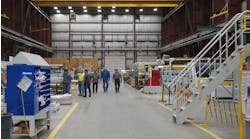Most industrial analysts and trade groups agree that the expansion of shale-gas exploration and production is creating new jobs. Oil and gas companies are flocking to shale-gas fields, such as the Marcellus gas formation that spans several states in the North, including eastern Ohio, Pennsylvania and New York.
All signs point toward shale gas having a positive effect throughout the natural-gas supply chain from suppliers to customers. Earlier this month, natural-gas advocates proudly linked to a Wall Street Journal article in their newsletters and on their websites about the construction of a new Vallourec & Mannesmann Holdings Inc., steel plant in Youngstown, Ohio, that will produce steel tubes for the shale-gas industry.
In addition, several chemical producers have announced plans to build ethane cracking plants near shale formations. But the extent of the shale-gas industry's contribution to overall job creation is still up for debate. If you listen to oil and gas industry groups, shale gas has created a new gold rush of sorts in small, often economically depressed towns.
In 2010 alone, the Pennsylvania Marcellus Shale gas industry contributed to $11.2 billion in economic activity, generated $1.1 billion in state and local taxes and supported nearly 140,000 jobs, according to the Marcellus Shale Coalition, an association of natural gas producers located in the Marcellus region. The figures were based on a Coalition-led report released July 20 that Penn State University researchers conducted.
But other researchers, many of whom are associated with environmental, labor and competing energy groups, say the job-growth figures cited by the industry are greatly exaggerated.
"Given the evidence so far, Marcellus isn't going to be Pennsylvania's next steel industry," says Stephen Herzenberg, an economist with the Keystone Research Center, a Pennsylvania policy think tank formed by unions. "It's not going to be a silver bullet in terms of the economy in Marcellus' four states."
Whose Figures Are Correct?
The Marcellus Shale Coalition and other gas-industry groups derive their jobs figures from "new hires" rather than newly created positions, Herzenberg says. In other words, they're counting the employment of people who are replacing jobs that were previously vacated through layoffs, attrition or other means.
Since the end of 2007, the Marcellus Shale industry has created fewer than 10,000 jobs in Pennsylvania, Herzenberg says.
The Marcellus Shale Coalition stands by its numbers. The figures are in line with Pennsylvania Department of Labor and Industry findings, says Marcellus Shale Coalition spokesman Travis Windle.
The coalition cites a Pennsylvania labor department statistic that shows employment in Pennsylvania's Northern Tier, where shale gas development is most concentrated, employment has jumped 1,500%.
Who is Filling the Jobs?
The other issue raised in the jobs debate is how many positions are being filled by local workforces. Residents in some towns complain they're being overrun by trucks with out-of-state license plates. Herzenberg says there isn't much published data available regarding local job creation.
In 2012 Orion Drilling Co. LLC plans to ramp up an operations and maintenance facility in Pennsylvania's Marcellus region, says Brett Schellenberg, a marketing executive with the company. Corpus Christi, Texas-based Orion plans to hire more than 100 workers by the third quarter of 2012. Initially, the company will transfer experienced employees from Texas to the Marcellus site.
The company plans to launch an aggressive job-hiring campaign in the region and within five years employ a 100% local workforce, Schellenberg says. But there are some challenges the company faces with the local employment pool.
"The current workforce does not currently have the skills and training required to operate the machinery," Schellenberg says. "We do, however, have training programs in place to educate the local workforce on how to run the equipment."
The company plans to send Pennsylvania workers to South Texas so they can train with experienced crews and learn the company's processes, Schellenberg says.
Some technical and community colleges are stepping up to provide training for workers wishing to enter the shale-gas industry. For instance, in Ohio's Marcellus region, Eastern Gateway Community College has established a program that trains students for entry-level natural gas drilling and production jobs.
If the region can develop skilled workers and the shale-gas industry is correct in its jobs projection, the payoff could be huge for job seekers. That's because typical rig jobs pay between $60,000 and $120,000 a year, Schellenberg says.
See also:
Shale Gas: The New Black Gold
Bayer Explores Ethylene Possibilities in Shale Gas Field
EIA Defends Shale Gas Claim



